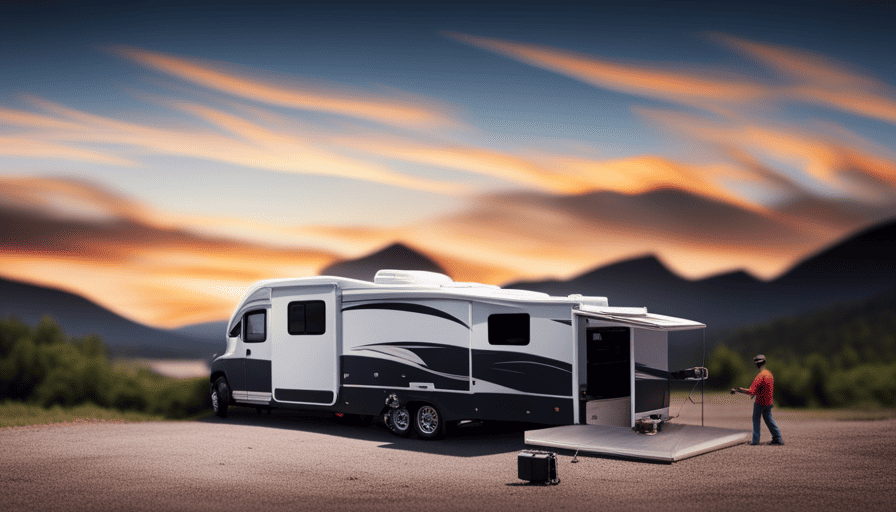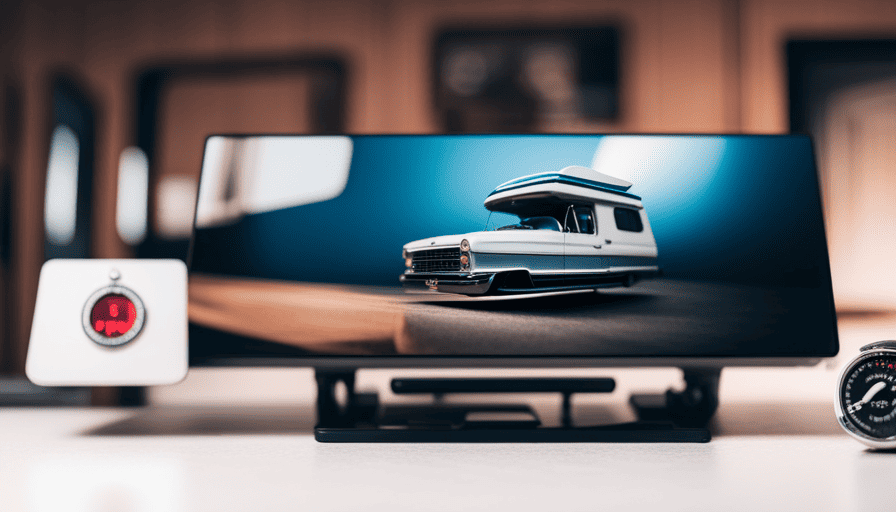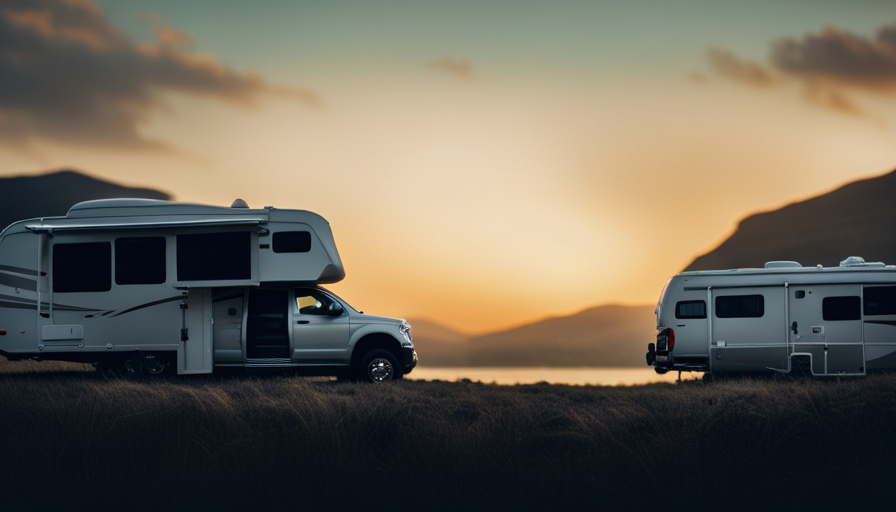Are you prepared to take to the highways and set off on a memorable journey with your fifth wheel camper? Get ready, because I’m going to guide you through the process of connecting your fifth wheel camper like an expert, sharing wisdom and insights along the way.
Picture this: you’re standing at the hitch of your tow vehicle, ready to connect it to your camper. The sun is shining, the birds are singing, and the excitement is palpable in the air.
With my step-by-step guide, you’ll learn how to:
- Prepare your tow vehicle
- Attach the hitch
- Level your camper
- Connect the electrical and brake cables effortlessly.
But that’s not all! I’ll also show you how to securely attach the kingpin to the hitch, perform a thorough safety check, and ensure a smooth and worry-free journey.
So, grab your toolbox and get ready to become a master of fifth wheel camper hook-ups. Let’s dive in and make your next adventure one for the books!
Key Takeaways
- Properly preparing the tow vehicle and checking tire pressure and towing capacity are essential steps before hooking up a fifth wheel camper.
- Choosing the right hitch type and securely attaching it to the tow vehicle is crucial for a stable connection.
- Leveling the camper using stabilizer jacks or a leveling system ensures stability and comfort during the trip.
- Connecting electrical and brake cables, inspecting connectors for damage, and properly installing brake cables are important for safe towing.
Prepare Your Tow Vehicle
Now that you’ve got your fifth wheel camper ready to go, it’s time to prepare your tow vehicle so you can hit the road with confidence.
Checking the tire pressure is a crucial step in ensuring a safe and smooth towing experience. Properly inflated tires not only improve stability but also help with fuel efficiency. Use a tire pressure gauge to check the pressure of all the tires, including the spare. Adjust the pressure as needed according to the recommended levels in your vehicle’s manual.
Next, it’s important to inspect the towing capacity of your tow vehicle. This information can usually be found in the owner’s manual or on the manufacturer’s website. Make sure that your tow vehicle is capable of safely towing the weight of your fifth wheel camper. Exceeding the towing capacity can put unnecessary strain on your vehicle’s engine, transmission, and brakes, leading to potential accidents or damage.
With the tire pressure checked and the towing capacity confirmed, you are now ready to attach the hitch to your tow vehicle. This critical step will ensure a secure and stable connection between the camper and the tow vehicle.
Attach the Hitch to Your Tow Vehicle
First, make sure your tow vehicle has the appropriate hitch installed for towing a fifth wheel camper. Choosing the right hitch for your tow vehicle is crucial in ensuring a safe and successful connection. There are various types of hitches available, such as fixed hitches, sliding hitches, and gooseneck hitches. It’s important to select a hitch that’s compatible with both your tow vehicle and the weight of your fifth wheel camper.
Once you have the appropriate hitch, follow these tips to ensure a secure and stable hitch connection. Start by positioning your tow vehicle and aligning it with the fifth wheel camper’s kingpin. Lower the tailgate of your truck and slowly back up until the hitch and kingpin are aligned. Engage the hitch lock mechanism to secure the connection.
Next, double-check that the hitch is locked and secure by giving it a gentle tug. This’ll help you verify that the hitch is properly engaged and won’t come loose during your journey. Additionally, consider using safety chains for added security.
With the hitch successfully attached to your tow vehicle, you can now transition into the subsequent section about leveling your fifth wheel camper. It’s important to ensure that your camper is level to prevent any issues with stability and comfort during your trip.
Level Your Fifth Wheel Camper
Ensure your fifth wheel is perfectly balanced for a smooth and enjoyable camping experience. Here are four steps to level your fifth wheel camper:
-
Adjust the Stabilizer Jacks: Begin by positioning your fifth wheel in your desired camping spot. Once parked, lower the stabilizer jacks until they make contact with the ground. Use a level to check the camper’s position from side to side and front to back. If it’s not level, adjust the jacks accordingly until the camper is stable.
-
Use a Leveling System: If your fifth wheel camper is equipped with a leveling system, activate it to automatically level the unit. Follow the manufacturer’s instructions to ensure proper operation and make any necessary adjustments.
-
Check the Level: After using the stabilizer jacks or leveling system, re-check the level of your camper to ensure it is perfectly balanced. Make any additional adjustments as needed.
-
Connect the Electrical and Brake Cables: Once your fifth wheel camper is level, transition into the next step of connecting the electrical and brake cables for a safe and secure towing experience.
By following these steps to level your fifth wheel camper and adjust the stabilizer jacks or use a leveling system, you’ll be well on your way to a comfortable and stable camping adventure.
Connect the Electrical and Brake Cables
Once your fifth wheel is level, simply plug in the electrical and brake cables for a safe and secure towing experience.
When connecting the electrical cables, it’s essential to ensure a proper and secure connection. Start by inspecting the connectors for any signs of damage or corrosion. If there are any issues, it’s crucial to troubleshoot and fix them before proceeding.
Next, align the connectors and push them together firmly until they click into place. Give them a gentle tug to make sure they’re securely attached.
Moving on to the brake cables, it’s vital to emphasize the importance of proper installation. Begin by checking the brake system to ensure it’s in good working condition. Look for any signs of wear or damage, and address any issues promptly.
Attach one end of the brake cable to the fifth wheel’s brake system and the other end to the towing vehicle’s brake controller. Make sure the connections are secure and that there’s no excessive slack in the cable. This will ensure proper braking performance while towing.
With the electrical and brake cables connected, you’re now ready to move on to the next step: attaching the kingpin to the hitch. This step is crucial for a secure and stable towing experience.
Attach the Kingpin to the Hitch
Now it’s time to secure your towing experience by connecting the kingpin to the hitch, giving you a smooth and stable journey ahead.
When it comes to choosing the right hitch for your fifth wheel camper, it’s crucial to consider the weight and size of your trailer. The hitch should be able to handle the load and provide a secure connection between the camper and your towing vehicle. It’s recommended to consult with a professional or refer to the manufacturer’s guidelines to ensure you choose the appropriate hitch.
Proper maintenance of the kingpin and hitch connection is essential for a safe and worry-free towing experience. Regularly inspect the kingpin and hitch for any signs of wear or damage. Lubricate the moving parts to prevent rust and ensure smooth operation. Additionally, check the connection before each trip to make sure it’s secure and tight. If you notice any issues or abnormalities, it’s important to address them promptly to prevent any accidents or damage.
Now that the kingpin is securely attached to the hitch, it’s time to move on to the next step of raising the landing gear. This will allow you to level your fifth wheel camper and ensure stability during your journey.
Raise the Landing Gear
After securely connecting the kingpin to the hitch, it’s time to elevate the landing gear, allowing you to level your fifth wheel and ensure a smooth and stable journey ahead.
Lowering the landing gear is a crucial step in preparing your camper for travel. To do this, locate the landing gear controls near the front of your fifth wheel. Use the controls to slowly raise the landing gear until the camper is level and stable.
When raising the landing gear, it’s important to keep an eye out for any issues or malfunctions. Common troubleshooting landing gear issues include slow or jerky movements, strange noises, or difficulty in extending or retracting the gear. If you encounter any of these issues, it’s best to refer to your owner’s manual or seek professional help to avoid further damage or safety hazards.
To ensure a successful connection, it’s essential to test the stability and strength of the landing gear. This can be done by gently pushing or pulling on the camper to check for any excessive movement or looseness. If everything feels secure, you can proceed with the next step of your fifth wheel setup.
Test the Connection
Before you hit the road, it’s time to put your connection to the test and ensure a secure and smooth journey ahead. Testing the connection is crucial to ensure the safety of your fifth wheel camper.
First, you need to test the brake system. This is essential to make sure that the brakes are working properly and can effectively stop the camper when needed. Engage the brake controller and apply the brakes to check if they engage smoothly and without any issues.
Additionally, it is important to inspect the towing capacity of your vehicle. Make sure that your vehicle can safely tow the weight of the camper and that the hitch is properly installed and secured. Check the owner’s manual of your vehicle for the towing capacity and compare it with the weight of the camper.
Once you have tested the brake system and inspected the towing capacity, you can move on to securing the fifth wheel camper. This ensures that the camper stays in place during your journey, providing stability and peace of mind.
Secure the Fifth Wheel Camper
To keep your home on wheels stable and secure, it’s time to fasten your ride like a sailor securing a mighty ship to the dock.
Securing a fifth wheel camper involves ensuring proper weight distribution and choosing the right hitch type.
Proper weight distribution is crucial for a safe and smooth journey. Make sure the weight is evenly distributed between the front and rear axles of your tow vehicle. This will prevent any instability or swaying while on the road.
Choosing the right hitch type is equally important. There are different types of hitches available, such as gooseneck and fifth wheel hitches. The fifth wheel hitch is specifically designed for fifth wheel campers and offers a secure connection. It provides a stable and seamless towing experience, giving you peace of mind during your travels.
Once you have ensured proper weight distribution and chosen the right hitch type, it’s time to secure the fifth wheel camper. Attach the trailer to the hitch, making sure it’s firmly locked in place. Double-check all connections, including safety chains and electrical wiring, to ensure everything is secure and functioning properly.
Now that your fifth wheel camper is securely fastened, it’s time to perform a safety check to ensure everything is in order.
Perform a Safety Check
After securely attaching the fifth wheel camper, it’s crucial to perform a safety check before hitting the road. As an experienced camper, I know the importance of maintaining the camper to ensure a smooth and safe journey.
One of the first things I do is perform regular maintenance on the camper, checking for any loose or damaged parts that could pose a risk while traveling.
Next, I focus on the tires, as they play a vital role in the camper’s stability. I start by checking the tire pressure using a reliable gauge, ensuring that it matches the recommended levels specified in the owner’s manual. It’s important to remember that improper tire pressure can lead to uneven wear and potential blowouts, which can be dangerous on the road.
To paint a clearer picture, imagine the following checklist for a safe camper adventure:
- Inspect all exterior lights to ensure they’re working properly.
- Check the brake system for any signs of wear or malfunction.
- Verify that the propane tanks are securely fastened and not leaking.
- Test the smoke and carbon monoxide detectors to guarantee they’re functioning correctly.
By diligently performing these maintenance tasks and safety checks, you can confidently hit the road and enjoy your adventure without any worries.
Hit the Road and Enjoy Your Adventure!
Now, it’s time to hop in and embark on an unforgettable adventure, embracing the open road and all the wonders it has in store for you! As you hit the road with your fifth wheel camper, there are a few things you need to keep in mind to ensure a smooth and enjoyable journey.
First and foremost, make sure you have all the packing essentials for your trip. This includes clothing, toiletries, cooking utensils, and any other personal items you may need. Don’t forget to pack some games, books, or other forms of entertainment to keep yourself occupied during downtime at the campground.
Speaking of campgrounds, choosing the right one is crucial. Research and find a campground that suits your preferences and offers the amenities you desire. Whether you prefer a secluded spot in the woods or a lively campground with activities and events, there are options for everyone. Consider factors like location, facilities, and nearby attractions when making your decision.
To make it easier for you, here’s a handy table outlining the key factors to consider when choosing a campground:
| Factor | Description |
|---|---|
| Location | Proximity to attractions, scenic views, and convenience to main roads |
| Facilities | Availability of water, electricity, sewer hookups, showers, and Wi-Fi |
| Amenities | Recreation areas, swimming pools, hiking trails, and organized activities |
| Nearby Attractions | Proximity to national parks, lakes, beaches, and other points of interest |
By considering these factors and packing the essentials, you’ll be well-prepared to hit the road and enjoy your adventure with your fifth wheel camper. So buckle up, turn up the music, and get ready for an incredible journey filled with memories that will last a lifetime.
Frequently Asked Questions
What are the weight limits for towing a fifth wheel camper?
When it comes to towing a fifth wheel camper, understanding weight limits is crucial for a safe and successful journey. The weight limits refer to the maximum load your vehicle can handle while towing the camper.
It’s important to check your vehicle’s towing capacity, which is the maximum weight it can safely tow. Exceeding these limits can lead to serious damage to your vehicle and jeopardize your safety on the road.
Always prioritize safety and stay within the recommended weight limits for a worry-free adventure.
How do I properly connect the brake cables to ensure safe braking while towing?
To properly secure brake cables and ensure safe braking while towing, it’s crucial to follow a few important steps.
Firstly, make sure the cables are securely attached to both the towing vehicle and the fifth wheel camper.
Then, check for any signs of wear or damage and replace them if needed.
Regularly inspect and maintain the brake system, including the brake pads and fluid levels. This ensures optimal performance and safety on the road.
Remember, proper brake maintenance is paramount for a smooth and secure towing experience.
What type of electrical connection is required to power the lights and appliances in the fifth wheel camper?
To power the lights and appliances in a fifth wheel camper, a secure electrical connection is crucial. The most common type of electrical connection is a seven-way RV plug, which provides power for brake lights, turn signals, and other electrical components. It’s important to ensure the connection is clean and free from corrosion to maintain a reliable power supply.
Additionally, always follow safety precautions, such as turning off all electrical power before connecting or disconnecting the plug to prevent accidents.
Are there any additional safety measures I should take before hitting the road with my fifth wheel camper?
Before hitting the road with my fifth wheel camper, I always make sure to take additional safety measures and follow a pre-trip checklist.
Firstly, I inspect the tires for proper inflation and tread wear.
Then, I check all the lights, including brake lights and turn signals, to ensure they’re functioning correctly.
I also make sure the hitch is securely attached and the safety chains are properly connected.
Lastly, I double-check that all appliances and equipment are turned off and properly stowed.
By following these steps, I can ensure a safe and worry-free journey.
How do I ensure that my fifth wheel camper is properly balanced and stable while towing?
Ensuring stability and proper weight distribution is crucial when towing a fifth wheel camper. One common mistake is neglecting to properly distribute the weight, which can lead to swaying and instability on the road.
To avoid this, make sure that the majority of the weight is positioned over the axles of the tow vehicle and that the fifth wheel hitch is properly aligned.
Additionally, double-check that the camper’s tires are inflated to the recommended pressure for a smoother and safer ride.
What is the Maximum Weight a Fifth Wheel Camper Can Tow?
The camper towing weight explained refers to the maximum weight that a fifth-wheel camper can tow. This weight includes the weight of the camper itself, as well as any cargo, equipment, and passengers inside. It is important to check the vehicle’s towing capacity and consult the manufacturer’s guidelines to ensure safe towing practices.
Conclusion
And there you have it, folks! Hooking up a fifth wheel camper may seem like a daunting task, but with the right preparation and a little know-how, it becomes a breeze.
I can’t stress enough how important it is to perform a thorough safety check before hitting the road. Remember, safety first!
So go ahead, embark on your adventure with confidence, and let the open road be your playground. Happy camping, and may your travels be filled with endless fun and unforgettable memories!










